In 2012, the eyes of the world were on London. You along with 215 million viewers watched the world’s top athletes compete in the Summer Olympic Games in hopes of bringing sports highest honor back to their home country. To host the summer games, the City of London transformed 560-acres of industrial east London into the innovative and sustainable Queen Elizabeth Olympic Park.

Credit: Olympic.org
But what happens to Olympic Parks after the medals are won, the athletes have returned home and the fanfare is over? These big investments can financially burden a city and draw criticism from its residents. In the case of London, advanced planning is allowing this Olympic Park to transform into a state-of-the-art facility for sports, arts, culture, entertainment, education, and day-to-day life. The Park will continue on as a world class sporting facility, and it will also include new residential housing that will make up five new neighborhoods, recreation facilities, and cultural and event quadrants all surrounded by the natural beauty of waterways and parklands. Constructed with sustainability at its heart, Queen Elizabeth Olympic Park goes beyond incorporating sustainability into its design and construction. The Park promotes a sustainable lifestyle with ample and easily accessible opportunities for walking and bicycling.
One year to the day of the 2012 summer Olympic opening ceremony, Queen Elizabeth Olympic Park had another opening to celebrate – the opening of the north of the Park segment. This established the Park as a destination for residents and visitors alike and a staple in the city’s community landscape. The Park continues to inspire the Olympic spirit in the city long after the flame has moved on to Rio de Janeiro and future host cities.
Today, as we continue our series on the world’s BIG projects, we hear from Mark Camley, Executive Director of Park Operations and Venues at Queen Elizabeth Olympic Park and the London Legacy Development Corporation. He tells us how planning, flexibility and public input have been key to the Park’s success and shares what residents and visitors have to look forward to as the Park continues to progress. We welcome his insights.
– – –
How did the decision to use the Olympic Park as a public space come to fruition? Were there any other contending ideas for ways to reuse the Olympic park?
Queen Elizabeth Olympic Park is much more than just a public space. It offers the best in sporting and cultural amenities while at the same time will offer people places to live, work and learn. The obvious legacy of the London 2012 Games was to secure the future of the permanent venues at the Park. This has been achieved and of the five sporting venues at the Park, four of them are already being used by both local communities and elite athletes, with the fifth, the Stadium, set to open for five matches of the Rugby World Cup in 2015. The Park will also be the location of up to 6,800 new homes across five new neighbourhoods where new nurseries, community centres, schools and health facilities are also being constructed. As well as this a new cultural and education quarter is planned for the Park that will see partners such as the Victoria & Albert Museum and University College London attract new visitors to the area.
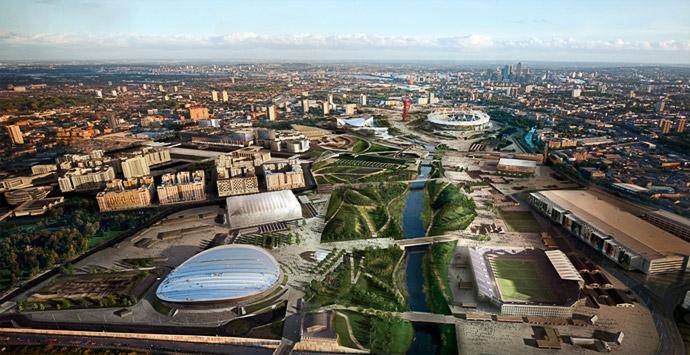
London’ s Queen Elizabeth Olympic Park
(Credit: London Legacy Development Corporation)
What is the vision and goal of the park?
The London Legacy Development Corporation is the body responsible for the management of Queen Elizabeth Olympic Park. The Legacy Corporation was formed to use the once-in-a-lifetime opportunity of the London 2012 Olympic and Paralympic Games and the creation of Queen Elizabeth Olympic Park to develop a dynamic new heart for east London, creating opportunities for local people and driving innovation and growth.
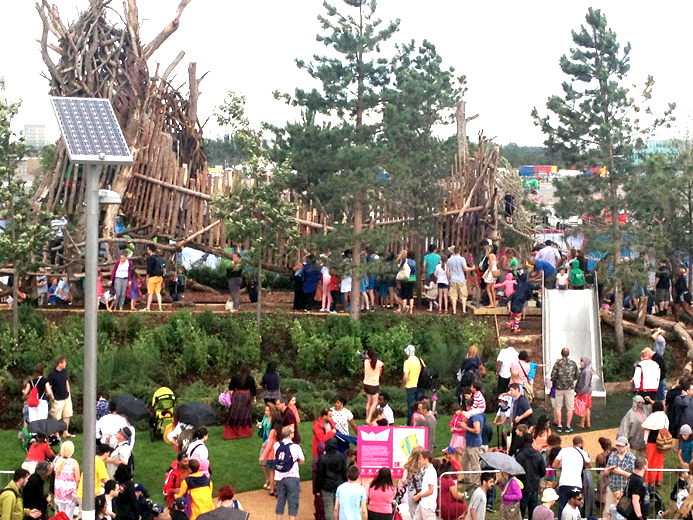
The Tumbling Bay Playground part of Queen Elizabeth Olympic Park’s north of the park segment.
(Credit: Adventure Playground Engineers)
Did you go to the community to solicit ideas for how to use the space?
We are proud to consult local people on all aspects of the Park’s development. Consultations are held on major projects and local people are invited to contribute ideas for how the Park can shape the development of the local area. This has lead to local people coming up with the names of the Park’s five new neighbourhoods, a Legacy Youth Panel who discuss how the Park is working with the local community and we’ve worked hard with local disabled people to ensure the Park is accessible to everyone.
Were there any challenges that arose from public input? If so, how were they addressed?
The key to public engagement has been to be open and honest, and deliver on commitments. We set ourselves a challenging timescale to re-open the north of the Park just a year to the day following the opening ceremony of the London 2012 Games. Opening at 2pm on that day to visitors eager to enter the Park was a real thrill.
How was the final design chosen and what did this process look like?
The north of the Park was largely designed before London 2012. Design teams were engaged to create a new park hub, the Timber Lodge Café, and a spectacular nature based playground, the Tumbling Bay playground. Our processes required our priority themes, including local employment and engagement to be adhered to. The designs also needed to fit with the general feel of the landscape.
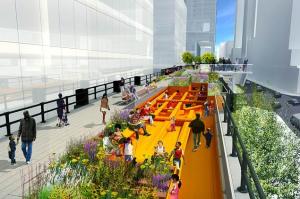
A conceptual simulation of a portion of New York City’s Highline Park.
(Credit: Friends of the Highline)
Are there any other large public park projects that inspired the design or intention of Queen Elizabeth Olympic Park?
The design of the southern part of the Park was led by James Corner Field Operations, who designed the Highline in New York. A number of the Park furniture features and the planting by Piet Oudolf mirrors the High Line. The Tumbling Bay playground in the north took some of its inspiration from the Princess Diana Memorial Playground in Kensington Gardens.
How was the progress reported to the public?
We held regular resident meetings and forums, including for our Youth Panel and Built Environment Access Panel. This enabled us to test ideas and ensure that the community were at the heart of the new landscape. More formerly, we attended various planning committees to gain permission for the work.
Have there been any lessons learned from this transformation of East London?
The three key lessons are – plan, plan, plan (and then be ready to be flexible if there are obstacles). The only way that the opening to time and budgets was achieved was through careful planning of design and testing them out with public and stakeholders.
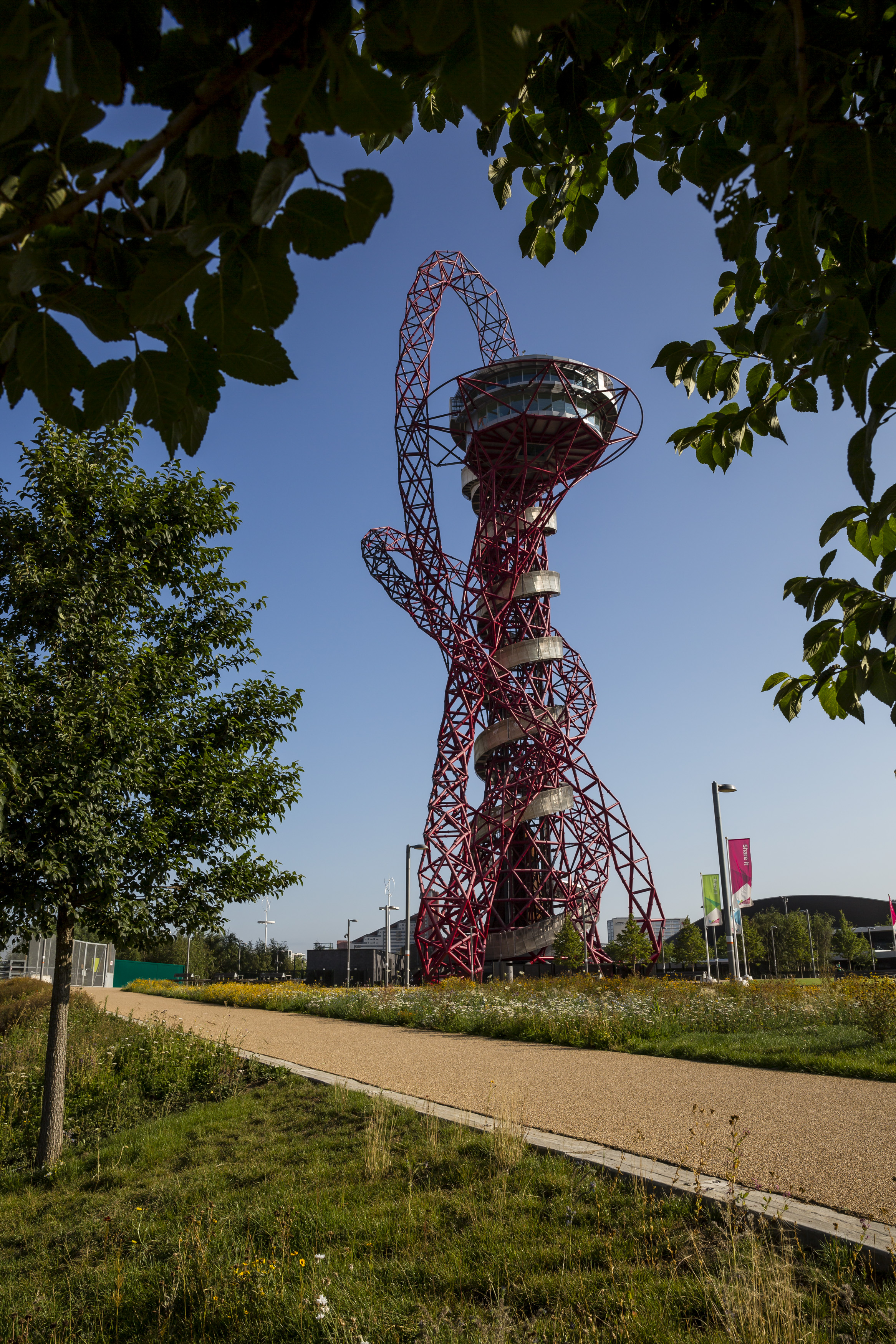
The Arcelormittal Orbit sculpture at Queen Elizabeth Olympic Park.
(Credit: Queen Elizabeth Olympic Park/London Legacy Development Corporation)
What are unique and new components of the park?
As London’s newest visitor destination, Queen Elizabeth Olympic Park, is a place unlike any other. Visitors to the Park are able to enjoy beautiful parklands and waterways, world-famous sporting venues, arts and events and spectacular views from the ArcelorMittal Orbit. As a new heart for east London, the Park will also provide new homes, jobs and a cultural and education quarter. Visitors are able to enjoy world-class sporting venues that have been transformed to be used by both the local community and elite athletes, stroll in beautifully landscaped parklands, enjoy interactive water fountains and adventure playgrounds and explore free themed walking trails filled with fascinating facts about the Park.
Are there any local secrets to using the park?
The north of the Park is much quieter than the south and is home to the Timber Lodge Café a community hub nestled within the beautiful parklands. Timber-clad it both reflects and enhances the natural environment, with solar panels to produce its own green energy. There is a café which is perfect for relaxing in and flexible space for schools and community groups, and children can enjoy the Tumbling Bay Playground adjacent to the building, one of the UK’s most imaginative large-scale adventure play areas.
It is also worth noting that the Park is built around the waterways, so there are pathways and bridges at different levels, which offer different walks and different perspectives of the Park.
The ArcelorMittal Orbit, the UK’s tallest sculpture, is the highest point in the Park and provides panoramic views across the whole Park, including in to the Stadium. In contrast, the Great British Gardens are in a quiet corner and provide a small oasis of calm.
What are some sustainable features of the park?
The Park is designed with sustainability at its heart. This means that it has been built in a sustainable way and has been designed to help future visitors and residents live sustainably. It is designed to do this in a number of ways, from promoting a healthy and sustainable lifestyle which encourages walking and cycling through safe and pleasant routes across the Park, through to using green building techniques that reduce the impact of development.
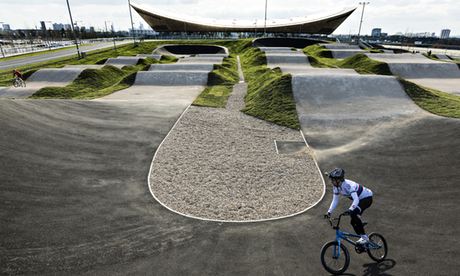
Lee Valley Velopark at Queen Elizabeth Olympic Park.
(Credit: David Levene via Guardian News and Media Limited)
Once inside, what are the transportation options within the park?
We’ve worked hard to ensure that Queen Elizabeth Olympic Park really is a park for all. The Park has been designed to be as accessible and inclusive as possible for a wide range of visitors, employees and future residents. The Park is easy to walk and cycle around and has good step-free access, hard-standing surfaces, regular seating and accessible Blue Badge car parking for each of the venues. A mobility service is available to support visitors with mobility impairment and recently the Park started running boat tours to give visitors a whole new perspective of the stunning scenery.
Since it’s opening, how popular has the park been compared to projected usage?
On Friday 22 August, the Park welcomed its 3 millionth visitor since reopening on 27 July 2013. The reaction, from both local people and those from further afield, has been hugely positive, whether its children playing in the fountains and wonderful playgrounds or swimming in the wake of champions in the London Aquatics Centre.
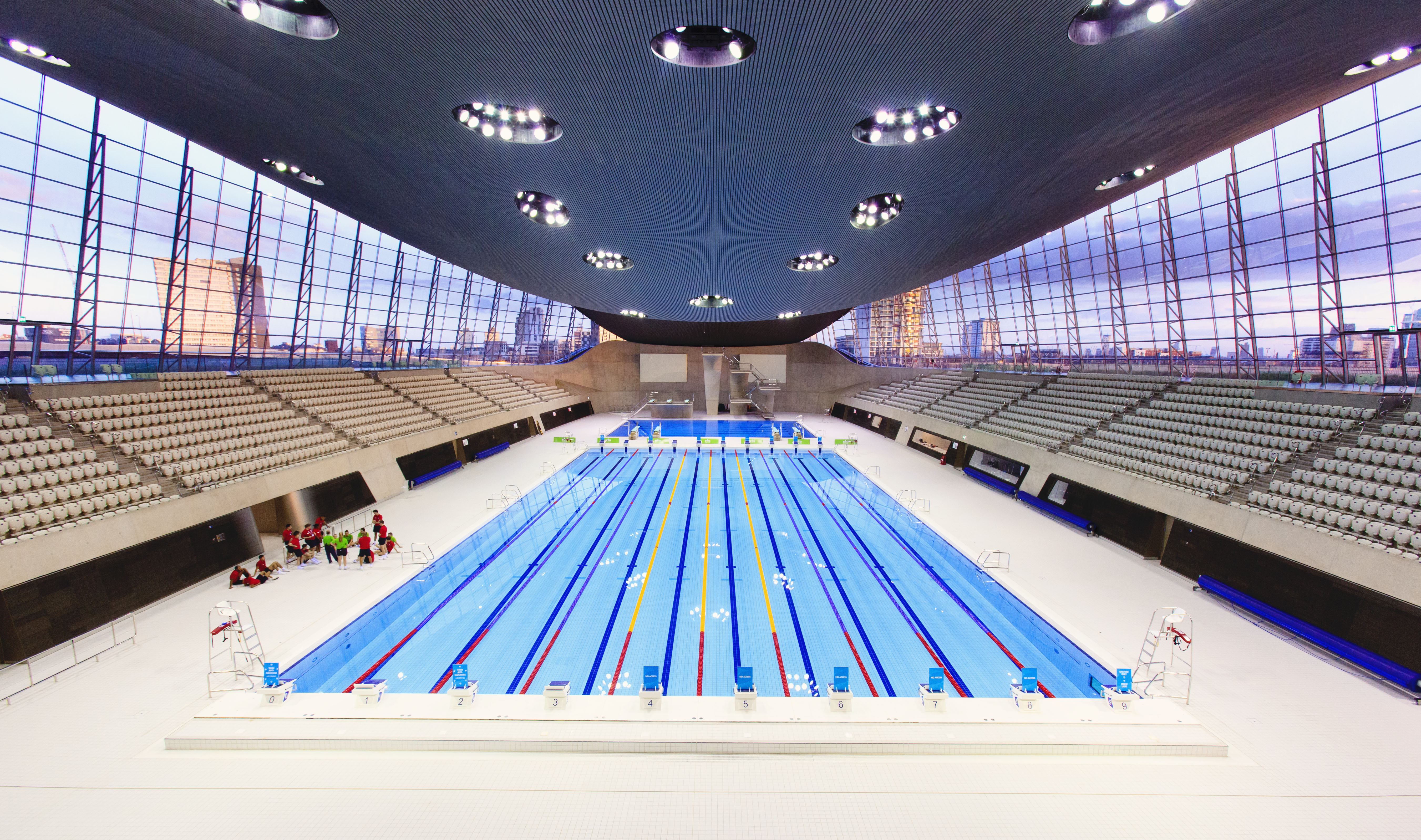
The London Aquatics Centre at Queen Elizabeth Olympic Park.
(Credit: Queen Elizabeth Olympic Park/London Legacy Development Corporation)
How is the park maintained?
We have a Park Manager and Head of Estates and Facilities Management who look after the landscape and venues. They have produced a 10 year management plan and have already been successful in achieving a Green Flag award for the Park. As well as professional landscape staff, we have volunteers working on maintaining the gardens and parkland.
What can visitors look forward to in the future at the park?
There is so much happening and coming up at Queen Elizabeth Olympic Park, from local community projects to large scale events such as the Invictus Games which occurred last month (September 10-14). Transformation of the Stadium is on track to be ready for five matches of Rugby World Cup 2015 before work is completed for West Ham United to kick off in 2016. Building is underway on the Park’s first neighbourhood, Chobham Manor, with residents set to move in by late 2015 and we are also excited about the Park’s new cultural and education quarter, Olympicopolis, which will bring together a range of educational and artistic partners such as the V&A museum and UCL.
– – –
London has set a great example for other host cities on how to re-use their Olympic size investments. Stay up to date with the Queen Elizabeth Olympic Park on Facebook, Twitter and Google+.
Liz Faris, Account Manager
Collaborative Services, Inc.

Recent Comments